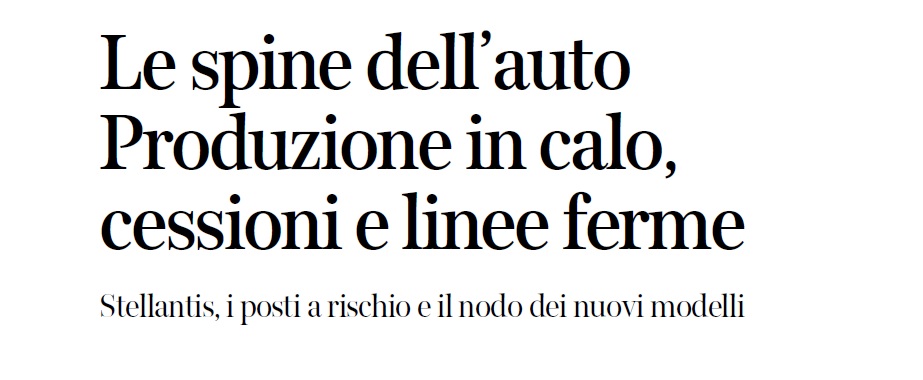Cairo’s Corriere della Sera tarmacs Elkann’s Stellantis (Republic)

The Italy of cars has stopped racing. In fact, it's just stopping. And Corriere della Sera overwhelms Stellantis for this… Facts, numbers and insights
It is no news that the Italian automotive world is at a standstill and that it risks being found highly unprepared to face the challenge of challenges: the energy transition that will decree the alternation of traditional cars to electric ones. Start talks about the many problems and shortcomings on a daily basis, including at a European level, where the automotive industry accounts for 2.6 million jobs in the manufacturing sector and more than 13 million jobs overall. Numbers that make this sector one of the most important in Europe and in Italy.
In our country there are about 250,000 male and female workers involved, of which 168,000 concern the components supply chain. If anything, the real novelty is represented by the weight that Corriere della Sera decides to give to the matter, focusing it on the responsibilities of Stellantis led by John Elkann , in turn owner of the Gedi Group and, therefore, of Repubblica .

“Italy's weight on the automotive front, within the framework of the European Commission, is becoming increasingly fragile and seems to favor France and Germany”, reads the article published in the via Solferino masthead. “Countries that have fiscal space for state aid for sectors that support the ecological transition (batteries, hydrogen, carbon, renewable energy, e-fuel), creating a rift with Italy which has greater spending constraints in the build its green passage”.
And then ample space is given to the latest study by Fiom CGIL which at the end of March certified that the Italian auto industry has gone "from producing around 1,500,000 vehicles at the end of the 1990s to 473,000 in 2022" (over 250 thousand are ducat). Italy is at a crossroads, although there is still a network of companies that have the ability to work with competence and quality, and despite "the process of industrial desertification underway, there is no link with reality in terms of public policies ».
Already last year the Promotor Study Center had given ample prominence to the increasingly evident arrest of the Italian automotive industry: in 1989 in Italy 1,971,969 cars were produced against 442,432 in 2021, with a downward trend that has continued in recent years: 542,007 (-19.5%) in 2019, 451,718 (-16.7%) in 2020, down to -2.1% in 2021.
As a result, the turnover of automotive components also decreased in our country: in 2016 it amounted to 57.2 billion, while in 2020, also due to the impact of the pandemic, it amounted to 44.8 billion. As for maintenance and repair spending, after the strong setback in 2020 (-18.9%), in 2021 it returned to growth, marking a +5.8% for a turnover of 28.7 billion, still far from the levels of 2019 (33.4 billion). A minus also for registrations which, after +5.5% in 2021, between January and June 2022 recorded -22.7%, France instead recorded -16.3%, Germany -11% , the United Kingdom -11.9%.
Promotor's analysis also underlined the excessive age of the Italian vehicle fleet, which in 2020 was 11 years and 8 months, against 10 years and 3 months in France, 9 years and 8 months in Germany, 9 years and 4 months in United Kingdom. In Italy, the study center points out, cars are not only old, but also many, with a rate of 67 cars in circulation per 100 inhabitants, compared to Germany which has 58, France 57, the United Kingdom 54.
ITALY FOLLOWS THE EU ON THE PRODUCTION OF CARS
Even a recent report by Acea , the association of manufacturers of the Old Continent, is rather gloomy: although in our country, in fact, 476,000 units were produced in 2022 with an improvement of +6.5% compared to the data for the year previous year, 10.7 million units were produced in the rest of the EU in 2022, with a growth of +7.1%. The Italian figure is, therefore, lower than the Community average. And by a lot compared to individual countries.
– Germany with 3.3 million units and a growth of +13.2%
– Spain with 1.7 million units and a growth of +6.5%
– Czech Republic with 1.19 million units and a growth of +8.7%
– Slovakia with 964 thousand units and a drop of -1.3%
– France with 940 thousand units and a growth of +10.3%
– Romania with 507 thousand units and a growth of +20.6%
– Italy with 476 thousand units and a growth of +6.5%
– Hungary with 441 thousand units and a growth of +6%
– Sweden with 257 thousand units and a growth of +1.6%
– Belgium with 235 thousand units and a growth of +6%
THE COURIER'S CRITICISM TO STELLANTIS
But, as we have seen, the Fiom report presents a substantially similar picture. "One of the junctions of the risk of decay of our manufacturing – reads the Corriere – could date back to October 2019 with the merger between FCA and PSA from which Stellantis was born, which just in recent days announced a record profit of 16, 8 billion. The decision to confirm the registered office in the Netherlands can be considered a sign of distance. While the merger has shifted the axis of management a lot towards Paris. The recruits of CEO Carlos Tavares, considered one of the most competent, but also toughest auto managers, are showing a group that sees strong centralization. Where Italy's role is increasingly similar to that of Germany in relation to the Opel brand, sold to Stellantis.”
“Another step – always reproaches the Milanese newspaper – was the sale of Magneti Marelli , passed to the Japanese of Calsonic Kansei. A jewel of components, decisive in the future vision of electric mobility, to which is added digitization, autonomous driving, artificial intelligence, a technological heritage that has always been closely linked to the Fiat Research Center (an example for all was the development of the common rail that modulated the injection of diesel into the engine, sold in 1994 to Bosch), a company for which today there is no certainty that it will play a role in the group's future strategies”.
Then the situation in which the establishments find themselves throughout the boot is listed. A situation that obviously clashes with the record numbers made by Stellantis in the past 12 months and with those, probably even more sensational, of the maxi salary of Tavares : Mirafiori, at this point completely unpacked, has already carried out 32 layoff shifts from January 1st to today , which involved around 1,800 workers; Cassino reduced to 5,000 units per month: 33 days of closure have already been carried out, with 3,000 workers in charge (historical minimum) due to sales (the registrations of FCA and PSA before the merger, underline the Corriere, were higher to those of the current Stellantis).
“In Pomigliano d'Arco – they note from via Solferino – an average of 15,000 vehicles travel a month — Alfa Romeo Tonale, Dodge Hornet, Fiat Panda — with layoffs of 20 days from the beginning of the year. Melfi is also walking at a reduced pace, the lines are still for over 6,000 employees, until August 2023, for whom layoffs have been triggered. The production of the Fiat 500X is destined to end and it is not yet known which models could replace it. A panorama that sees, with the most conservative estimates, the risk of losing 9,000 jobs".
THE ALARMS (NEVER LISTENED) OF THE UNIONS
An alarm that has so far been raised several times by the trade unions, however falling punctually on deaf ears, in the disinterest of politics and the media. Michele De Palma , Fiom Secretary General, in inaugurating the two-day extended extraordinary meeting of the Automotive Committee of IndustriAll Europe last November, underlined : “Today Italy is the country that pays more than others for the transition because in recent years there it was industrial policies, it's time for a change. Investments in research and development, new technologies, software and infrastructures are needed for a just, socially and environmentally sustainable transition. Technological change must be an opportunity to relaunch the sector in our country, make it a protagonist again in Europe and make production sustainable with new models and through new producers."
In the same office, Luc Triangle , General Secretary of IndustriAll Europe, had zoomed out speaking of the entire Old Continent, which is increasingly aging especially at an industrial level: “The automotive industry is undergoing an unprecedented transformation. Large-scale job losses, increased pressure on remaining workers and social damage will be inevitable if the electrification and automation of the industry continues to be left to market forces alone."
“We need – he added – a European industrial strategy to maintain and create good jobs, while decarbonising the sector. We need investment to transform existing plants and develop the supply chains needed to produce the vehicles we need in Europe and around the world to address the climate urgency. To ensure a just transition and keep workers on board in this industrial revolution, we need to have negotiated strategies that better anticipate the changes underway. EU policy is currently too weak on these crucial aspects to ensure that the Green Deal is socially just! Without social justice, there is a risk that it will fail for us and for the planet. You need to act urgently now. EU politicians have agreed on the principle, but now we need to see concrete proposals”. Who knows if after this curbing of the Corriere to the governance of Stellantis something will happen instead, at least at a political level.
This is a machine translation from Italian language of a post published on Start Magazine at the URL https://www.startmag.it/smartcity/il-corriere-della-sera-di-cairo-asfalta-stellantis-di-elkann-repubblica/ on Mon, 17 Apr 2023 09:41:55 +0000.
